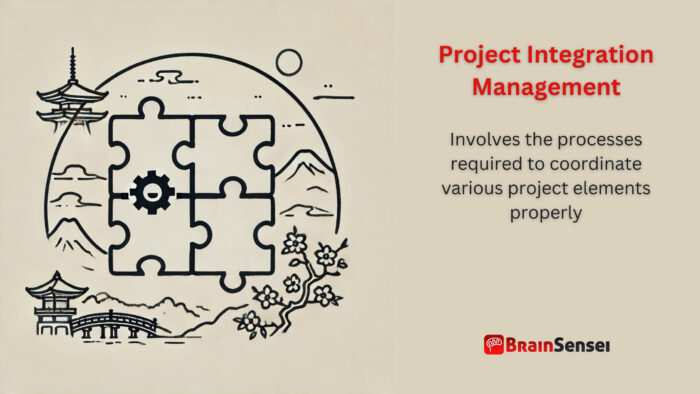
Project Integration Management
What is Project Integration Management?
Project integration management involves the processes required to coordinate various project elements properly. It focuses on making trade-offs among competing objectives and managing interdependencies to achieve project goals successfully.
Key Takeaways
- Ensures project activities and components align with objectives
- Involves decision-making regarding resource allocation and prioritization
- Includes processes like project plan development, execution, and integrated change control
- Enhances communication and collaboration across project teams
Understanding Project Integration Management
How It Works
Project Integration Management requires comprehensive oversight to combine and coordinate project processes. It starts with developing a project charter and plan, ensuring all elements align with business goals. Project execution follows, which entails resource allocation and performance monitoring. Change control processes address deviations from the plan, ensuring projects stay on track.
Notes
- Misalignment between project components can cause significant delays
- Proactive communication and collaboration are critical for success
- Regular review and adjustments help maintain project alignment
- Overlooking change management can result in scope creep
Related Terms
- Project Scope Management: Defines what the project includes.
- Project Schedule Management: Focuses on timely project delivery.
- Project Cost Management: Manages budget requirements.
- Project Risk Management: Identifies and mitigates potential risks.
- Project Quality Management: Ensures project deliverables meet requirements.
Examples of Project Integration Management
Manufacturing Industry
A manufacturing company implementing new production equipment must integrate procurement, installation, and training processes. Project managers coordinate between departments to minimize disruptions while ensuring the equipment meets performance requirements. This process involves detailed planning, supplier negotiations, and workforce training to ensure the new equipment enhances productivity without halting existing operations. Cross-departmental meetings help align goals, while contingency plans address potential technical issues.
Healthcare Industry
A hospital launching a new patient management system integrates IT, training, and operations teams. The project manager oversees the system installation while ensuring staff training and patient care are not compromised. This project requires selecting appropriate software, configuring it to meet healthcare standards, and conducting multiple training sessions for diverse staff roles. Regular feedback loops and simulations help identify potential issues early. Additionally, the team must maintain compliance with health information privacy regulations throughout the project.
Telecommunications Industry
A telecom company expanding network coverage requires integrating site acquisition, equipment procurement, and regulatory compliance. Project managers synchronize these activities to ensure timely project completion. The process includes negotiating with property owners for cell tower locations, coordinating with equipment vendors, and working with government agencies for permits. Technical teams conduct field tests to validate network performance, while marketing teams prepare promotional campaigns to announce the expanded coverage. Regular cross-functional meetings ensure all departments stay aligned.
These examples illustrate the complexity and importance of integration management across industries, emphasizing the need for meticulous planning, collaboration, and adaptability.
Use Cases of Project Integration Management
United States (Construction)
A U.S.-based construction firm is developing a new commercial complex. The project requires integrating design, construction, and regulatory processes to meet deadlines and comply with local building codes. The project manager coordinates with architects, contractors, suppliers, and government agencies. Regular status meetings and digital project management tools are employed to track progress. Change requests, such as design modifications or unforeseen structural issues, are handled through a structured change control process. Success hinges on effective communication, proactive problem-solving, and continuous performance monitoring, including regular review and adjustments to maintain project alignment.
Europe (Transportation)
A European railway operator embarks on an ambitious infrastructure upgrade project. The objective is to modernize signalling systems across multiple regions while ensuring uninterrupted train services. The project manager must synchronize activities across engineering teams, IT specialists, and external vendors. Challenges include coordinating track closures with public schedules, training staff on new technologies, and securing regulatory approvals. The team mitigates risks and minimizes disruptions through integrated communication platforms and scenario planning, ultimately enhancing passenger safety and network efficiency.
Asia (IT Development)
An Asian IT company initiates a project to develop and deploy a multi-platform e-commerce application. The project scope includes frontend design, development, cybersecurity measures, and payment integration. The project manager oversees team collaboration across different time zones and cultural contexts. Agile methodologies and cloud-based tools facilitate seamless communication. Critical success factors include aligning development milestones with marketing strategies, ensuring compliance with regional e-commerce regulations, and conducting thorough user acceptance testing before launch. The integrated management approach ensures timely delivery and high customer satisfaction, highlighting the need for meticulous planning, collaboration, and adaptability.
Best Practices of Project Integration Management
Effective project integration management requires adherence to several best practices.
First, project managers must develop a comprehensive project plan that includes input from all stakeholders. Doing so ensures consideration of diverse perspectives and reduces the likelihood of oversight. The plan should detail the scope, objectives, timelines, resources, and potential risks. Involving key stakeholders from the beginning fosters a sense of ownership and facilitates smoother collaboration.
Second, establishing clear communication channels is critical. Projects often involve cross-functional teams that must stay updated on progress, challenges, and changes. Communication tools like Slack, Microsoft Teams, or Asana can enhance information flow. Regular meetings, whether daily stand-ups or weekly status reviews, help maintain alignment and identify potential issues early.
Another essential practice is monitoring project performance. This activity tracks key performance indicators (KPIs) related to time, cost, quality, and scope. Tools like Microsoft Project or Primavera P6 provide real-time insights into project status. The project team must conduct performance reviews at predefined milestones to assess progress and implement corrective actions if necessary.
Implementing an effective change management process is equally important. Projects rarely proceed according to the plan; unexpected challenges or opportunities often necessitate adjustments. A structured change control process ensures that proposed changes are evaluated based on their impact on the project’s objectives, resources, and timeline. Project managers must document all changes, communicate them to relevant stakeholders, and update the project plan accordingly.
Furthermore, fostering a collaborative project culture can significantly impact integration success. Team-building activities, recognition programs, and transparent communication create a positive working environment. Collaboration platforms integrating with project management tools allow teams to share documents, provide feedback, and track tasks efficiently.
Lastly, continuous learning and process improvement should be part of the project management strategy. Conducting post-project reviews to evaluate successes, challenges, and lessons learned helps refine integration practices for future projects. Training programs and certifications, such as those offered by PMI, can also enhance project managers’ skills and knowledge.
Common Mistakes and Issues
Failing to engage stakeholders early can result in misaligned objectives. For instance, a software development project that neglects regular communication with end-users may deliver a product that does not meet customer expectations. Poor communication across teams also often leads to duplicated efforts or conflicting priorities, resulting in delays and increased costs. A lack of a structured change management process can cause scope creep, where projects expand beyond their original goals. Furthermore, insufficient risk management practices may leave the project vulnerable to unforeseen obstacles, such as supply chain disruptions or regulatory changes. Project managers sometimes underestimate the importance of documentation, which can hinder knowledge transfer and create confusion during team transitions. Addressing these issues requires proactive planning, continuous monitoring, and a commitment to process improvement.
Frequently Asked Questions (FAQs)
Why is Project Integration Management important?
It ensures cohesive coordination across various project components, facilitating the achievement of project goals.
What are the key processes in Project Integration Management?
The primary processes include project plan development, execution, and integrated change control.
How does change control work in Project Integration Management?
Change control involves evaluating, approving, and implementing changes to the project plan.
Who is responsible for Project Integration Management?
The project manager typically oversees integration management activities.
What tools do the team use in Project Integration Management?
Integration management often uses tools like Microsoft Project, Primavera P6, and Asana.
Additional Resources
Preparing for a PMI certification?
- Exam Prep Courses: PMP®, CAPM®, and PMI-ACP®
- Exam Simulators: PMP®, CAPM®, PMI-ACP®, PMI-PBA®, PMI-RMP®, PMI-SP®, PgMP®, and PfMP®
- Professional Development Units (PDUs): 15, 30, and 60 PDU Bundles



